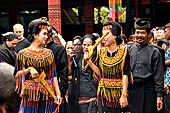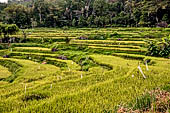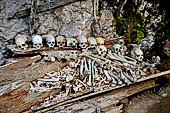| enter keyword to search: |
|
Images db
|
|
|
Articles db
|
|
|
|
|
|
|
| Tana Toraja Traditional Settlement |
|
Tana Toraja, a secluded territory surrounded by mountains and hills at about 1,500 to 2,000 masl in the north of South Sulawesi, has become a popular tourist destination for the unique house architecture of boat-shaped roofs called Tongkonan and the traditional ceremonial funerals.
After a 300 km drive with a private car from Makassar we reached Rantepao, the chaotic uninspiring dirty capital of Tana Toraja. After a stop at Pare-Pare the road climbed the mountain range of Enrekang. At a place called Buntu Kabobong we stopped at a warung with panoramic views over the mountain range of Gunung Bambapuang and distant views of the Toraja hills. Finally gates marked with tongkonan warned us that we entered in the Toraja region.
In Rantepao there are some hotels that can be used as base for tours that can be organised to visit the various sites spread both in the northern hills around Batutumonga and along the river valley south to Makale.
the traditional funeral ceremony |

|
First day
Spread around the area of Bori Parinding there are several tongkonan compounds immersed in rice-fields and grazing ground for water buffalo and pigs that have replaced the original bamboo forest. The climate makes possible an abundant production of rice as well as crops like coffee and cocoa. In the village we attended the traditional funeral ceremony.
The ceremonial ground, called ‘rante’, was prepared in a large grassy field with specially made shelters for audiences and other structures, and the screeching of pigs, strapped to long pieces of bamboo, left on the ground to squeal.
Funerals are important ceremonies in Tana Toraja, it is believed that without proper funeral rites the soul of the deceased will not only enter the second life, but also will bring a misfortune to the whole members of the family. The funeral is an elaborate and expensive event, to rise the funds needed the ceremony is often held for weeks, months, or even years after the death, while the body is kept in a room of the house where the family sleeps. Although Torajan funeral tradition can vary depending on a particular village, a typical ceremony lasts for 4 days. The first day is a procession, during which the deceased is visiting the whole village. Second day is the "receiving", when all the guests arrive and are welcomed by the family members. In the third day there is the bloody slaughter of many buffaloes and pigs (the Torajans believe that the animals should follow people in the second life). The buffalo is considered a sacred animal and the price for an albino buffalo can be very high. Buffalo carcasses, including their heads, lined up on a field while parts of the slaughtered animals are given as 'gifts' and carefully noted. On the fourth day the body is finally taken to the grave.
In the afternoon, after some tropical rain, we visited Pallawa, maybe the most interesting compound of traditional houses. The houses and granaries are arranged in two parallel rows aligned east-west direction with the houses facing North and granaries facing South.

|
Pallawa
|
Second Day
Hike up to Batutumonga about 20km north of Rantepao. At the beginning of the path we had the chance to observe menhirs on ceremonial ground, each representing a merit performed in the past by a person of high status. Batutumonga occupies a dramatic ridge on the slopes of Gunung Sesean, with panoramic views of Rantepao and bowls of cascading rice terraces. We stopped for lunch in a panoramic restaurant that cater for the tourists.
From Batutumonga, we continued to Lokomata and Pana villages. Along the way: cave graves hewn into huge stone boulders scattered around, tiny villages with towering tongkonan, women pounding rice, buffalo and children splashing in pools. The trail continues down the hill slopes and ends at Tikala, from there we returned by car to Rantepao.
Batutumonga |

|
Third Day
Market day in Makale, a dusty noisy town south of Rantepao. The market is a blur of noise and colour: pigs strapped down with bamboo strips line up for buyers close inspection, various stalls sell local produce including coffee, tobacco, buckets of live eels, piles of fresh and dried fish, and jugs of ‘balok’, the local brew from fermented rice.
Immersed in the rice fields between Sangalla and Suaya there are the Royal Graves with the oldest tau tau effigies in Toraja. You must be related to the royal family to be buried here. It takes six months and five people work before the grave is cut into the stone cliffs. In nearby area some banyan trees serve as grave for babies who died before they reached six months of age. This are called ‘passieeiran’, literally “baby grave in the living tree”.
Nearby Londa there is a burial site below a shear rock wall with various sepoltures. Miniature tongkonans mark burial places where the bodies are buried on the ground. Various coffins hung from the rock face high from the ground, while burial chambers are carved 50 meters high from the wall of the cliff. Balconies of tau tau guard the entrances to a couple of caves at the foot of the rock, these are sepoltures for the more ordinary people. Inside the caves there is a collection of coffins, many of them rotted away, with the bones either scattered or heaped in piles.

|
The market of Makale
|
Surrounded by rice fields and water buffalo pastures, Ke'te Kesu site consists of houses and granaries and a burial place. The houses and granaries are laid out in the traditional arrangement, one of the houses serves as a museum. There are woodworkers and workshops where rice barns are being built. Unfortunately Ke’te Kesu have become a tourist trap with lots of stalls selling trinkets to tourists.
On the cliff face behind the village there are some caves and very old hanging graves. Rotting coffins are suspended on wooden beams. Others, full of bones and skulls, lie rotting in piles.
Ke'te Kesu |

|
| |
|
|
 |
|
|



